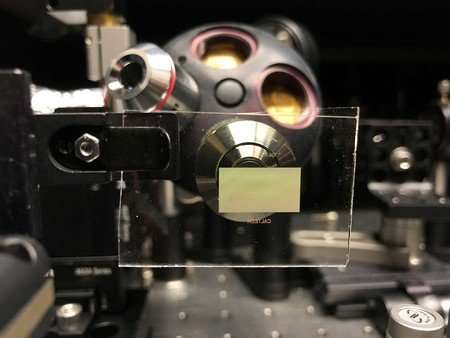Engineered metasurfaces replace adhesive tape in specialized microscope

The latest advance in a new type of optics aimed at improving microscopy started with a game of tennis three years ago.
Unwinding after a long day of research in their respective labs, Mooseok Jang (Ph.D. '16) and Yu Horie (who will receive his Ph.D. in June 2018)—at the time, both graduate students at Caltech—met up for a game of tennis at Caltech's Braun Athletic Center courts.
Jang, a student of Changhuei Yang—the Thomas G. Myers Professor of Electrical Engineering, Bioengineering, and Medical Engineering in the Division of Engineering and Applied Science—had been working on a nascent microscopy technology that uses light scattering to circumvent the traditional tradeoff between resolution (the amount of detail you capture) and field of view (the area you capture). The research had hit a roadblock: the tools that were being used to scatter light were difficult to predict and unreliable.
During the tennis match, Jang described this frustrating conundrum to Horie, a student of Assistant Professor of Applied Physics and Materials Science Andrei Faraon (BS '04). In Faraon's lab, Horie worked on metasurfaces, which are sheets of material whose electromagnetic properties can be altered on demand. Faraon, a nanophotonics engineer, creates metasurfaces that are studded with nanoscale posts made of silicon nitride. These nanoposts are capable of manipulating light with a high degree of precision—for example, to bend light like a lens does or encode holograms on a flat surface. As their conversation migrated from the tennis courts to coffee at the Red Door Marketplace at Caltech, Jang and Horie realized that the expertise of their respective labs could be combined to create a more reliable, predictable light-scattering material.
"As we talked, it became clear that we could work together to solve this problem," Jang says.
The practice of scattering light in order to take a high-resolution image with a wide field of view seems counterintuitive, but demonstrations over the past decade have shown that it can be effective. While scattered light does not propagate in a simple way like light passing through a lens, it can be processed for high-resolution optical focusing and imaging using a device called a spatial light modulator (SLM), which corrals and directs the raw scattered components to enable high-fidelity optical control. The result is an image with an increased number of resolvable focal spots that are spread out over a wider field of view—in other words, a clearer, broader image.
The problem, however, is that this strategy is difficult to practically implement, to the point of uselessness. In order to make sense out of the scrambled light, the SLM needs to know exactly how it was affected by the scattering medium. Different types of scattering media currently in use—including adhesive tape—are full of randomly located suspended particles. When a piece of tape is placed in the path of a beam of light, those particles do a great job of scattering light in a random fashion, which is the goal. However, because of the inherent random nature of their location in the tape, it can take weeks for the measurement process to fully characterize the scattering and enable high-quality focusing over the maximum number of individual points in an image. Worse, the suspended particles have a bad habit of migrating in the tape, even during the calibration process, which has the potential to render the painstakingly long measurement process worthless by the time it is finished.
With a scattering medium like adhesive tape, this characterization has traditionally meant calibrating the medium by projecting known images through it using the SLM and then working backwards to determine the action of the medium on the incoming light—then repeating this process over and over again to fully characterize the medium.
However, using the metasurfaces generated in Faraon's lab—materials that scatter light in entirely predictable ways—the calibration time could drop from hours to just minutes, converting the time-consuming measurement process to a simple alignment procedure. As an added bonus, recalibration would never be necessary.
"I think that Dr. Yang and his colleagues were skeptical at first that we could control light with such precision using these metasurfaces," Horie says. They were eventually convinced, however, and in a paper published in Nature Photonics this month, the two labs demonstrate the production of a high-resolution image—corresponding to a numerical aperture greater than 0.5—with a relatively wide (8 millimeter) field of view. The image had an estimated 2.2 billion individual focal spots. For comparison, a typical high-quality microscope with the same numerical aperture produces an order of magnitude fewer focal spots.
With continued improvements like this, scientists and pathologists will be able to scan samples with microscopes quicker and at a higher resolution.
"The hope is that our work will prompt further interest in this area of optics and make this type of microscopy and its advantages feasible for practical, everyday use—not just as a proof of concept," says Josh Brake (MS '16), a graduate student in Yang's lab who continues to work on the project with Faraon and Yang.
Since their breakthrough collaboration, Jang and Horie have finished their doctoral work and gone their separate ways: Jang returned to his native Korea, where he continues his research as part of his mandatory military service, while Horie took a job at Apple. The two stay in touch, though. And both still play tennis.
The Nature Photonics paper is titled "Wavefront shaping with disorder-engineered metasurfaces."
More information: Mooseok Jang et al. Wavefront shaping with disorder-engineered metasurfaces, Nature Photonics (2018). DOI: 10.1038/s41566-017-0078-z
Journal information: Nature Photonics
Provided by California Institute of Technology





















